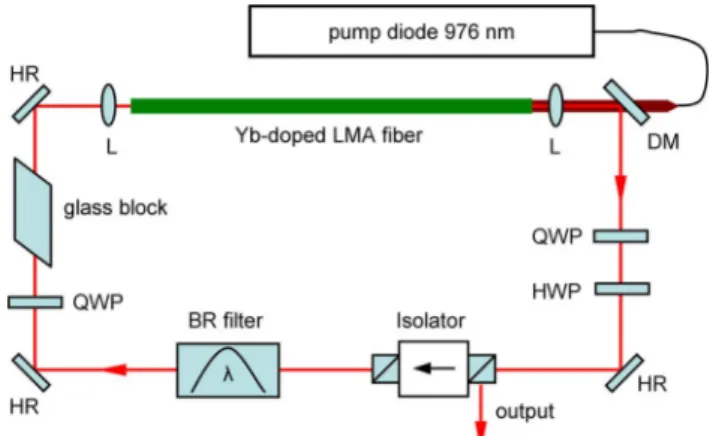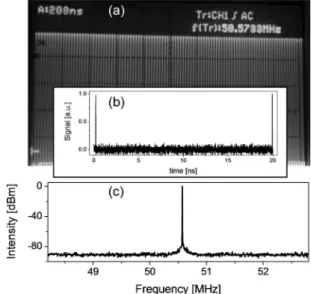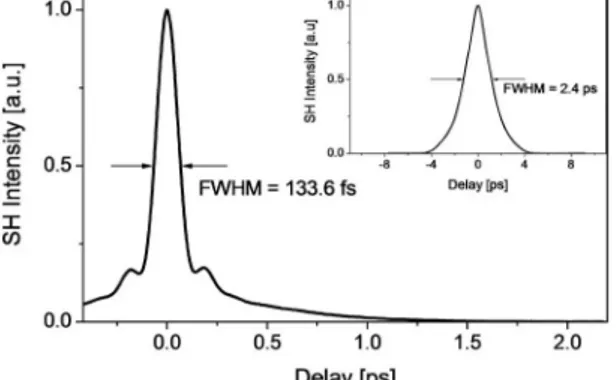High average and peak power femtosecond
large-pitch photonic-crystal-fiber laser
Martin Baumgartl,1,2,* Florian Jansen,1Fabian Stutzki,1Cesar Jauregui,1Bülend Ortaç,3Jens Limpert,1,2and Andreas Tünnermann1,2,4
1Friedrich-Schiller-University Jena, Institute of Applied Physics, Albert-Einstein-Strasse 15, 07745 Jena, Germany 2Helmholtz-Institute Jena, Max-Wien-Platz 1, 07743 Jena, Germany
3
UNAM-Institute of Materials Science and Nanotechnology, Bilkent University, 06800 Bilkent, Ankara, Turkey
4Fraunhofer Institute for Applied Optics and Precision Engineering, Albert-Einstein-Strasse 7, 07745 Jena, Germany
*Corresponding author: martin.baumgartl@uni‑jena.de
Received October 26, 2010; revised December 10, 2010; accepted December 17, 2010; posted December 22, 2010 (Doc. ID 137235); published January 12, 2011
We report on the generation of high-average-power and high-peak-power ultrashort pulses from a mode-locked fiber laser operating in the all-normal-dispersion regime. As gain medium, a large-mode-area ytterbium-doped large-pitch photonic-crystal fiber is used. The self-starting fiber laser delivers27 W of average power at 50:57 MHz repetition rate, resulting in534 nJ of pulse energy. The laser produces positively chirped 2 ps output pulses, which are com-pressed down to sub-100 fs, leading to pulse peak powers as high as 3:2 MW. © 2011 Optical Society of America
OCIS codes: 060.2310, 060.2320, 140.3510, 140.4050, 140.3615, 140.7090.
The development of powerful ultrashort pulse laser sources opens a door to the study and understanding of fundamental effects in nature. High-average powers combined with high pulse peak-powers are required to initiate nonlinear processes and allow for a reasonable detection procedure. A new generation of laser oscilla-tors with the highest-average-power levels to date have been demonstrated using Yb-doped thin-disk technology in efficient combination with ultrafast saturable
absorp-tion mechanisms [1,2]. However, the ultrashort pulse
generation from this active medium is limited, due to the relatively narrow emission bandwidth of common crystalline materials. On the other hand, Yb-doped opti-cal fibers possess promising properties with very large emission bandwidths and high single-pass gains. The la-ser performance in terms of average power and energy extraction is limited mainly by the excessive nonlinearity of the fibers. Significant progress concerning the perfor-mance of mode-locked fiber lasers in terms of pulse dura-tion and energy has been enabled by the development of new propagation regimes to overcome the limitations im-posed by nonlinearities. The most powerful mode-locked fiber lasers have been developed in the all-normal-dispersion regime. Such systems, supporting dissipative soliton pulse evolution, have been able to produce sub-100 fs pulses with energies as high as 31 nJ using
stan-dard single-mode fibers [3]. More recently, exceptional
performances in terms of pulse energy and peak power have been demonstrated in mode-locked fiber lasers by overcoming nonlinear effects using large-mode-area
(LMA) photonic-crystal fibers (PCF) [4–6]. Most of these
systems use a high modulation-depth semiconductor-based saturable absorber mirror (SAM) for nonlinear self-amplitude modulation. This limits average-power scaling owing to high nonsaturable losses of the absorber and low thermal conductivity of the substrate, which leads to a strong thermal load and to degradation of the SAM. Another approach is the use of a narrow spec-tral filter to achieve strong self-amplitude modulation
inside the laser cavity [7].
In this Letter, we report the generation of femtosecond pulses from an all-normal-dispersion fiber laser featuring a large-mode-area ytterbium-doped large-pitch photonic-crystal fiber. The combination of an instantaneous, nonabsorptive mode-locking mechanism [nonlinear po-larization rotation (NPR) technique] with a novel PCF de-sign in a spectral-filtering effect assisted chirped-pulse oscillator configuration enables a significant peak power enhancement with the generation of multimegawatt
pulses from a fiber laser. The laser reaches27 W of
aver-age power at a50:57 MHz repetition rate, corresponding
to 534 nJ pulses. The output pulses are extracavity
dechirped down to100 fs with 3:2 MW peak power. To
the best of our knowledge, these are the highest average and peak powers ever reached by a mode-locked fiber laser.
The high-power passively mode-locked fiber laser is
set up in a ring-cavity configuration, as shown in Fig.1.
The gain fiber was designed on the basis of numerical
simulations [8]. Different structures with variable
num-bers of air holes, pitch, and hole sizes were simulated in order to find the optimized set of parameters for robust single-mode operation. The fiber has a hexagonal lattice
Fig. 1. (Color online) Schematic set-up. L, lens; DM, dichroic mirror; HR, high reflection mirror; QWP and HWP, quarter- and half-wave plate; BR filter, birefringent filter.
244 OPTICS LETTERS / Vol. 36, No. 2 / January 15, 2011
of air holes, wherein the core is formed by one missing
hole in the center [Fig.2(a)]. The core is surrounded by
two rings of air holes. An air hole diameter of10 μm and a
large pitch of30 μm between them results in a mode field
diameter of41 μm for the fundamental mode at 1030 nm
wavelength. Hence, the fiber exhibits strongly reduced light intensities in the core while maintaining effectively single-mode behavior. Therefore, in spite of the large core of the fiber, the presented laser does not require
any additional mode-filter, unlike that presented in [4].
A 170 μm air cladding together with a high doping
concentration provides efficient pump light absorption
(24 dB=m small signal absorption at 976 nm). A fiber
length of1:2 m is chosen to obtain sufficient gain. In the
experiment, the fiber end faces are angled (6°) to
sup-press back reflections. A polarizing optical isolator ensures unidirectional operation, and its first polarizer serves as rejection port for the NPR mode-locking tech-nique. This rejection port is used as laser output at the same time. A set of one half- and two quarter-wave plates is used to control the output coupling ratio and the NPR in the fiber. To support dissipative soliton stability, a
bi-refringent filter with a 16 nm FWHM bandwidth is
em-ployed, resulting in further self-amplitude modulation.
Behind the filter, a block of 30 cm bulk fused silica is
placed in Brewster angle into the remaining free-space section, providing a small amount of prestretching before the pulse enters the fiber. The total cavity group-delay dispersion of the all-normal-dispersion setup, including
all bulk optical elements, is estimated to be ∼0:03 ps2.
The beam profile is monitored and the fiber yields an
excellent beam quality (M2¼ 1:2), as indicated by the
profile [Fig. 2(b)] measured in the high-power regime.
An optimization of the setting of the wave-plates results in stable mode-locked operation. The mode-locking threshold for this wave plate setting is reached at a pump
power of more than40 W. Increase of the pump to more
than 52 W leads to break up of cw single-pulse
mode-locking. A sudden power drop to ∼60% of the output
power is observed when the wave plates are rotated to switch the laser to cw operation, which is a sign of the strong influence of NPR. Without the filter, mode-locked states are hardly obtained, the operation is less robust, and the tendency to generate multipulsing states is in-creased. The spectral filter plays an important role for
pulse shaping in this laser, as discussed in [9]. In contrast,
by use of a very narrow spectral filter, mode locking is ob-tained easily for various wave plate settings, but for most of these cases, more than one pulse is circulating in the
cavity. The relatively broad 16 nm filter is found to be
an optimum. The highest output power for fundamental
mode locking is obtained at a pump power of∼52 W. With
this parameter setting the laser operates in a self-starting
single-pulse regime at a repetition rate of50:57 MHz. The
pulse train is monitored with a200 MHz analogue
oscillo-scope and a50 GHz sampling oscilloscope in combination
with an 18:5 ps response time photodiode to ensure
single-pulse operation (Fig.3). Furthermore, a long scan
range (150 ps) autocorrelator is used. The oscilloscope
trace [Fig. 3(a)] shows high amplitude stability. This is
confirmed by an rf spectrum analyzer measurement
[Fig.3(c)], which exhibits more than80 dB separation
be-tween the fundamental harmonic and the background. The laser delivers spectrally broad output pulses with a
full spectral width at half-maximum of32:5 nm at a
cen-tral wavelength of1032:4 nm. The spectrum is shown in
Fig.4. It possesses a steep-edged shape due to the strong
influence of self-phase modulation on pulse shaping. The
inset of Fig.5shows the autocorrelation trace measured
directly at the laser output. The positively chirped pulses
yield an autocorrelation width (FWHM) of 2:4 ps. The
trace exhibits a triangle-like shape, indicating that the stretched pulses mimic the quasi-rectangular spectral shape in the temporal domain. Using a high-efficiency
transmission grating pair with 1250 lines=mm, these
pulses are compressed externally to a minimum
autocor-relation width of134 fs (Fig.5), which corresponds to a
compression factor of 18. The dispersion provided by the
grating compressor is about−0:036 ps2. With a
deconvo-lution factor of 0.74, which is calculated from the power
Fig. 2. (Color online) (a) Microscope image of the fiber cross section. (b) Beam profile at27 W output power.
Fig. 3. (a) Pulse train on analog oscilloscope, (b) two conse-cutive peaks on a 50 GHz sampling oscilloscope (resolution 5 ps), (c) rf spectrum, resolution bandwidth 300 Hz.
Fig. 4. Optical spectrum; inset, logarithmic scale. January 15, 2011 / Vol. 36, No. 2 / OPTICS LETTERS 245
spectrum, the compressed pulse duration computes to a
value of98 fs. Hence, the duration is 20% above the
trans-form limit, which implies that the compressed pulses possess a residual higher-order phase, which cannot be compensated by the grating compressor. Because of the aforementioned complex temporal shape of the stretched pulses, they accumulate a certain amount of higher-order phase due to Kerr nonlinearity in the fiber.
In this regime with only52 W of pump power an average
power of 27 W is measured at the output of the laser,
yielding an optical-to-optical efficiency well above 50%.
This corresponds to pulse energies of 534 nJ. Hence,
the obtained pulse energy relative to the mode area of the fiber is comparable with the highest performance
achieved with standard single-mode
all-normal-dispersion fiber lasers [3]. The output coupling ratio is
estimated to be∼80%. The autocorrelation trace of the
compressed pulses is shown in Fig. 5. It exhibits a
ped-estal, which results both from the steep spectral shape and from the above-mentioned uncompensated higher-order phase. The amount of energy contained inside
the main pulse is estimated to be ∼75%. An additional
loss (20%) results from the grating compressor efficiency,
yielding427 nJ of compressed pulse energy. This,
conse-quently, results in a peak power of more than 3:2 MW,
which is, to our knowledge, the highest peak power gen-erated by a mode-locked fiber laser.
In conclusion, we have presented a passively mode-locked Yb-doped fiber laser based on a large-pitch photo-nic-crystal fiber. The unprecedented performance is enabled by the use of a very large-mode-area fiber that exhibits strongly decreased nonlinearity in combination with a nonabsorptive instantaneous mode-locking me-chanism and a spectral filter element. A relatively short fiber length and an additional amount of bulk dispersion
enables the generation of broadband pulses with27 W of
record average power corresponding to534 nJ of energy,
which could be compressed to a duration of 100 fs.
Hence, peak powers exceeding 3:2 MW are obtained
from a fiber.
We acknowledge support by the German Federal Min-istry of Education and Research (BMBF) under contract 13N10773 and the Inter Carnot & Fraunhofer Program under project APUS.
References
1. J. Neuhaus, D. Bauer, J. Zhang, A. Killi, J. Kleinbauer, M. Kumkar, S. Weiler, M. Guina, D. H. Sutter, and T. Dekorsy, Opt. Express16, 20530 (2008).
2. C. R. E. Baer, C. Kränkel, C. J. Saraceno, O. H. Heckl, M. Golling, R. Peters, K. Petermann, T. Südmeyer, G. Huber, and U. Keller, Opt. Lett.35, 2302 (2010).
3. K. Kieu, W. Renninger, A. Chong, and F. Wise, Opt. Lett.34, 593 (2009).
4. B. Ortaç, M. Baumgartl, J. Limpert, and A. Tünnermann, Opt. Lett.34, 1585 (2009).
5. M. Baumgartl, B. Ortaç, C. Lecaplain, A. Hideur, J. Limpert, and A. Tünnermann, Opt. Lett.35, 2311 (2010).
6. C. Lecaplain, B. Ortaç, G. Machinet, J. Boullet, M. Baumgartl, T. Schreiber, E. Cormier, and A. Hideur, Opt. Lett.35, 3156 (2010).
7. S. Lefrançois, K. Kieu, Y. Deng, J. D. Kafka, and F. W. Wise, Opt. Lett.35, 1569 (2010).
8. F. Jansen, F. Stutzki, H. Otto, M. Baumgartl, C. Jauregui, J. Limpert, and A. Tünnermann, Opt. Express 18, 26834 (2010).
9. A. Chong, W. Renninger, and F. Wise, J. Opt. Soc. Am. B25, 140 (2008).
Fig. 5. Autocorrelation traces, externally compressed pulse; inset, chirped pulse.


